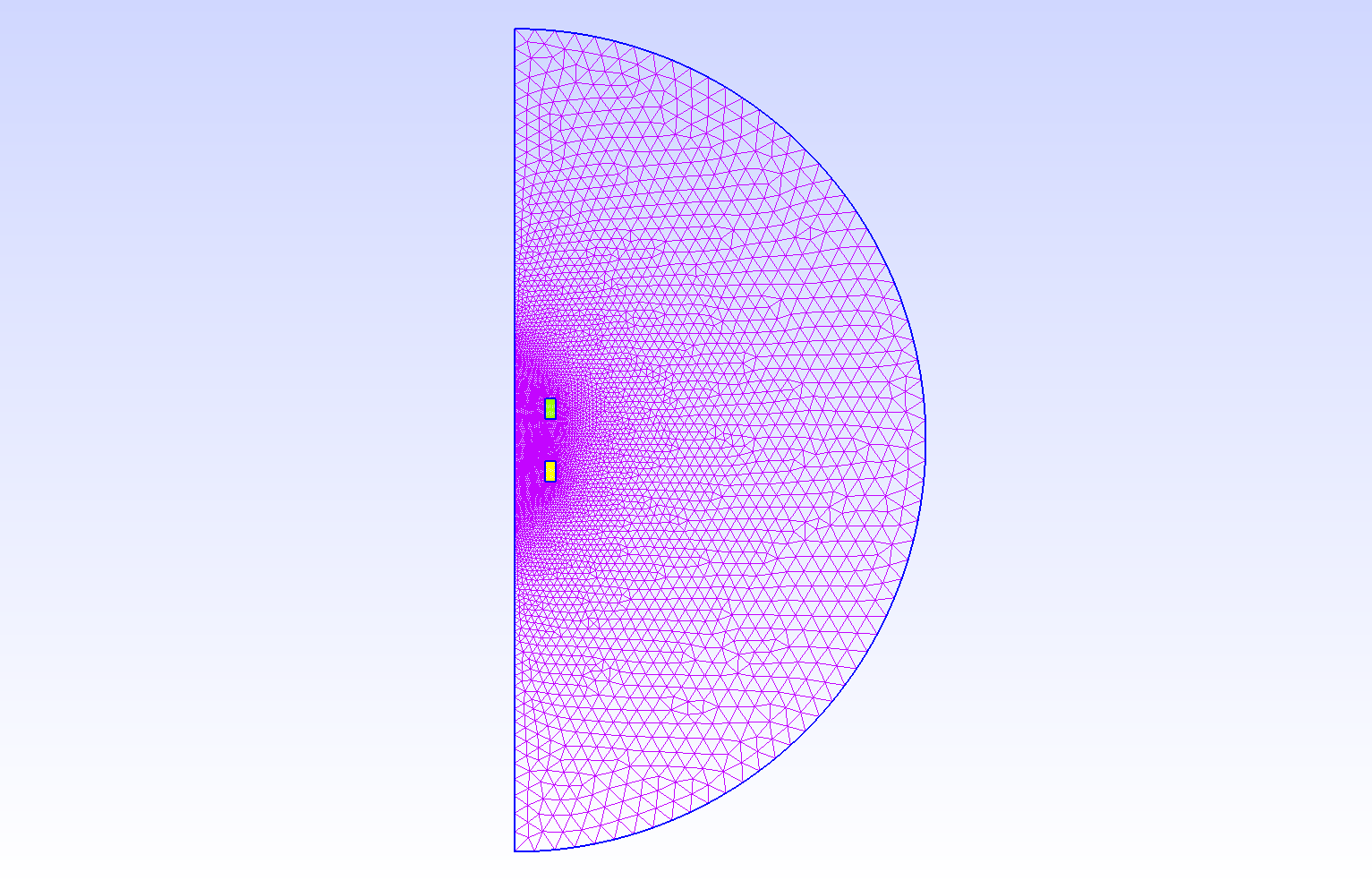Test Case : Two Torus
1. Introduction
This is the test case of Maxwell Quasi Static Problem with the A-V Formulation and Gauge Condition on a two torus geometry surrounded by air for the unstationnary case in axisymmetric coordinates.
2. Run the Calculation
The command line to run this case is :
mpirun -np 16 feelpp_toolbox_coefficientformpdes --config-file=mqs_axis.cfg --cfpdes.gmsh.hsize=1e-3
This case is run with the latest version 109 of Feelpp.
3. Data Files
The case data files are available in Github here :
-
CFG file - Edit the file
-
JSON file - Edit the file
-
GEO file - Edit the file
4. Equation
Assuming that \(V\) is known, the A-V Formulation in axisymmetric coordinates is :
With :
-
\(A_{\theta}\) : \(\theta\) component of potential magnetic field
-
\(\sigma\) : electric conductivity \(S/m\)
-
\(\mu\) : electric permeability \(kg/A^2/S^2\)
-
\(U\) : tension \(Volt\)
5. Geometry
The geometry is two rectangles in axisymmetric coordinates \((r,z)\) representing two conducting torus, surrounded by air.

Geometry in Axisymmetrical cut
|
.png)
Geometry in Axisymmetrical cut loop on Conductors
|
The geometrical domains are :
-
Conductor_0: the torus is composed by a conductor -
Conductor_1: the torus is composed by a conductor
Conductor_0 \(\cup\) Conductor_1 \( = \Omega_c^{axis}\)
|
-
Air: the air surroundingConductor_0andConductor_1-
zAxis:Air's bound, correspond to \(Oz\) axis (\(\{(z,r), \, z=0 \}\)) -
infty: the rest of theAir's bound
-
Air \(= \Omega^{axis} / \Omega_c^{axis}\).
|
Symbol |
Description |
value |
unit |
\(r_{int}\) |
interior radius of tores |
\(75e-3\) |
m |
\(r_{ext}\) |
exterior radius of tores |
\(100.2e-3\) |
m |
\(z_1\) |
half-height of tores |
\(25e-3\) |
m |
\(r_{infty}\) |
radius of infty border |
\(5*r_{ext}\) |
m |
6. Boundary Conditions
The Dirichlet boundary conditions imposed are :
-
On
zAxis: \(A_{\theta} = 0\) -
On
infty: \(A_{\theta} = 0\)
On JSON file, the boundary conditions are written :
"BoundaryConditions":
{
"magnetic":
{
"Dirichlet":
{
"ZAxis":
{
"expr":"0"
},
"Infty":
{
"expr":"0"
}
}
}
}
7. Weak Formulation
With \(\tilde{\nabla} = \begin{pmatrix} \partial r \\ \partial z \end{pmatrix}\)
8. Parameters
The parameters of the problem are :
-
On
Conductor_0andConductor_1:
Symbol |
Description |
Value |
Unit |
\(V_0\) |
scalar electrical potential of |
\( U_0 \, \frac{\theta}{2\pi}\) |
\(Volt\) |
\(U_0\) |
electrical potential of |
\(\begin{cases} \frac{t}{0.1} \quad\text{if } t <0.1 \\ 1 \quad\text{if } 0.1<t<0.5 \\ 0 \quad\text{if } 0.5<t<1 \end{cases}\) |
\(Volt / rad\) |
\(V_1\) |
scalar electrical potential of |
\( U_1 \, \frac{\theta}{2\pi}\) |
\(Volt\) |
\(U_1\) |
electrical potential of |
\(\begin{cases} \frac{t}{0.1} \quad\text{if } 0 < t < 0.1 \\ 1 \quad\text{if } 0.1 < t < 0.7 \\ 0 \quad\text{if } 0.7 < t < 1 \end{cases}\) |
\(Volt / rad\) |
\(\sigma\) |
electrical conductivity |
\(58e6\) |
\(S/m\) |
\(\mu=\mu_0\) |
magnetic permeability of vacuum |
\(4\pi.10^{-7}\) |
\(kg \, m / A^2 / S^2\) |
-
On
Air:
Symbol |
Description |
Value |
Unit |
\(\mu=\mu_0\) |
magnetic permeability of vacuum |
\(4\pi.10^{-7}\) |
\(kg \, m / A^2 / S^2\) |
On JSON file, the parameters are written :
"Parameters":
{
"sigma":58e6,
"mu":"4*pi*1e-7"
},
"Materials":
{
"Conductor_0":
{
"U":"t/(0.1)*(t<(0.1))+(t<(0.5))*(t>(0.1)):t",
//[...]
},
"Conductor_1":
{
"U":"t/(0.1)*(t<(0.1))+(t<(0.7))*(t>(0.1)):t",
//[...]
},
"Air":
{
//[...]
}
},
9. Coefficient Form PDEs
The Feelpp toolboxe Coefficient Form PDEs is used here. The coefficients associated to the Weak Formulation are :
-
On
Conductor_0andConductor_1:
Coefficient |
Description |
Expression |
\(d\) |
damping or mass coefficient |
\(\sigma r\) |
\(c\) |
diffusion coefficient |
\(\frac{r}{\mu}\) |
\(a\) |
absorption or reaction coefficient |
\(\frac{1}{\mu r}\) |
\(f\) |
source term |
\(- \sigma \frac{U_i}{2\pi} \, r\) with \(i={0,1}\) |
-
On
Air:
Coefficient |
Description |
Expression |
\(c\) |
diffusion coefficient |
\(\frac{r}{\mu}\) |
\(a\) |
absorption or reaction coefficient |
\(\frac{1}{\mu r}\) |
On JSON file, the coefficients are written :
"Materials":
{
"Conductor_0":
{
"U":"t/(0.1)*(t<(0.1))+(t<(0.5))*(t>(0.1)):t",
"magnetic_c":"x/mu:x:mu",
"magnetic_a":"1/mu/x:mu:x",
"magnetic_f":"-sigma*U/2/pi:sigma:U",
"magnetic_d":"sigma*x:sigma:x"
},
"Conductor_1":
{
"U":"t/(0.1)*(t<(0.1))+(t<(0.7))*(t>(0.1)):t",
"magnetic_c":"x/mu:x:mu",
"magnetic_a":"1/mu/x:mu:x",
"magnetic_f":"-sigma*U/2/pi:sigma:U",
"magnetic_d":"sigma*x:sigma:x"
},
"Air":
{
"magnetic_c":"x/mu:x:mu",
"magnetic_a":"1/mu/x:mu:x"
}
}
10. Numeric Parameters
-
Time
-
Initial Time : \(0s\)
-
Final Time : \(1s\)
-
Time Step : \(0.01s\)
-
-
Mesh size :
-
Interior of torus : \(0.001 m\)
-
Far of torus : \(0.004 m\)
-

Mesh of Geometry
|
11. Result
11.1. Magnetic Potential Field
The magnetic potential field \(\mathbf{A}\) defined by :
11.2. Magnetic Field
The magnetic field \(\mathbf{B}\) is defined by :
\(r\) component of Magnetic field \(B_r (T)\)
|
\(z\) component of Magnetic field \(B_z (T)\)
|
The behavior of \(\mathbf{B}_z\) on the \(O_z\) axis at \(t=15s\) :
h |
L2 Error Norm |
L2 Relative Error Norm |
\(9e-3\) |
\(4.235206e-2\) |
\(1.84\%\) |
\(5e-3\) |
\(2.294347e-2\) |
\(1.00\%\) |
\(1e-3\) |
\(3.908771e-3\) |
\(0.17\%\) |
\(5e-4\) |
\(1.292564e-3\) |
\(0.06\%\) |